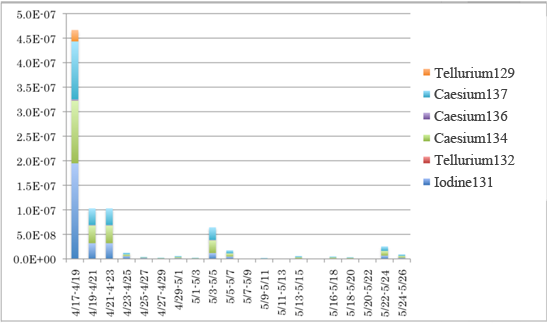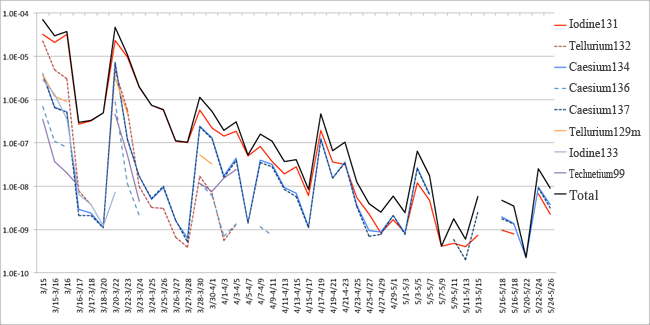KEK TOP >> English page >> Radiation monitoring >>
KEK | HIGH ENERGY ACCELERATOR RESEARCH ORGANIZATION
May 30, 17:00, 2011
Measurement result of airborne nuclide and air radiation level in Tsukuba area: ninth report
KEK, in conjunction with National Institute for Environmental Study (NIES) have been conducting the measurement to assess the airborne nuclide and air radiation level in Tsukuba area since 15 March. In this report, the results of measurements, conducted between 9 and 26 May, are shown in the chart below. Please refer to the previous reports for the measurement results before 9 May.
KEK will have another measurement hereafter, and will report the result accordingly.
Measurement condition:
- Measurement point: In the premise of NIES (16-2 Onogawa, Tsukuba-City, Ibaraki)
- Air sampling instrument: High-volume air sampler, with the capability of filling 600 litters of air per minutes . Each measurement took two days for the sampling.
- Filter used: Collected by a quartz fiber filter and doubly stacked activated carbon filters
Filter analysis instrument: KEK’s High Resolution Ge detector
Measurement result:
The measurement results are shown in Chart 1 to 3. We did not conduct measurement during the period between 37th and 38th measurements (15 to 16 May) due to the replacement work of the filters. The information on the weather conditions at the time of the measurements is posted on NIES’s web site (http://www.nies.go.jp/shinsai/).
The 41st measurement shows the rainfall-induced increase of radiation to 10-8Bq/cm3-level, which is still 1000 times lower than the radiation level measured in March.
Chart1 Results from 35th to 38th measurements: Detected nuclide and its concentration (Bq/cm3)
| 35th | 36th | 37th | 38th | |
| Measurement period | 5.9 11:49 - 5.11 11:39 | 5.11 11:45 - 5.13 11:44 | 5.13 11:50 - 5.15 11:50 | 5.16 13:22 - 5.18 10:28 |
| Air collected | 1,722 m3 | 1,727 m3 | 1,728 m3 | 1,623 m3 |
| Nuclide | CONC (Bq/cm3) | CONC (Bq/cm3) | CONC (Bq/cm3) | CONC (Bq/cm3) |
| I-131 | 4.8×10-10 | 4.0×10-10 | 7.3×10-10 | 9.6×10-10 |
| Te-132 | no detection | no detection | no detection | no detection |
| Cs-134 | 7.0×10-10 | no detection | 2.6×10-9 | 2.0×10-9 |
| Cs-136 | no detection | no detection | no detection | no detection |
| Cs-137 | 5.8×10-10 | 2.0×10-10 | 2.5×10-9 | 1.8×10-9 |
| Te-129m | no detection | no detection | no detection | no detection |
Chart2 Results from 39th to 42rd measurements: Detected nuclide and its concentration (Bq/cm3)
| 39th | 40th | 41th | 42th | |
| Measurement period | 5.18 10:35 - 5.20 10:35 | 5.20 10:52 - 5.22 10:52 | 5.22 12:00 - 5.24 11:38 | 5.24 11:45 - 5.26 10:45 |
| Air collected | 1,728 m3 | 1,728 m3 | 1,715m3 | 1,691 m3 |
| Nuclide | CONC (Bq/cm3) | CONC (Bq/cm3) | CONC (Bq/cm3) | CONC (Bq/cm3) |
| I-131 | 7.9×10-10 | no detection | 6.7×10-9 | 2.3×10-9 |
| Te-132 | no detection | no detection | no detection | no detection |
| Cs-134 | 1.4×10-9 | 2.2×10-10 | 9.6×10-9 | 3.7×10-9 |
| Cs-136 | no detection | no detection | no detection | no detection |
| Cs-137 | 1.3×10-9 | no detection | 9.2×10-9 | 3.1×10-9 |
| Te-129m | no detection | no detection | no detection | no detection |
Concentration of the airborne nuclide since 17 April (Bq/cm3)

Transition of concentration of the airborne nuclide since 15 March. Horizontal scale shows the measurement date, and vertical scale shows the concentration (Bq/cm3)

The chart shows peak values around March 28 to 5 April, 17 to 23 April, then smaller peaks around 3 to 7 May, and 22 to 26 May. One of the possible interpretations of these peaks may come from the global atmospheric circulation with roughly 16 to 19 days cycle, considering the observations of airborne radioactive nuclide overseas. Similar periodical behavior has been observed with the Chernobyl nuclear power plant accident.
[ Contact ] KEK Public Relations Office TEL:029-879-6047
mailto:proffice@kek.jp
HIGH ENERGY ACCELERATOR RESEARCH ORGANIZATION, KEK
1-1 Oho, Tsukuba, Ibaraki 305-0801 Japan
Copyright (C) KEK. All Rights Reserved.